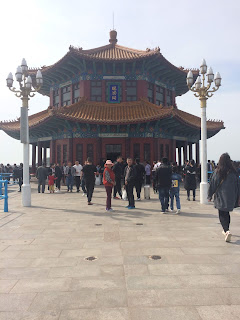大家好!
After my program ended, I decided to do a little traveling with one of my friends. The first place that we visited was Qingdao (青岛). Why 青岛?青岛 is a beautiful city on the ocean with a unique culture. It also is famous for the beer that they brew there and even though I don't drink beer what kind of Wisconsinite would I be if I did not visit the home of Chinese beer.
青岛 is a major city in Shandong Province. It is not the capital of the province but it is still a major city. In fact, it has the highest GDP of any city in the province. An interest fact, in 2018 青岛 was ranked number 31 in the Global Financial Centers Index. Other Chinese cities include: Hong Kong, Shanghai, Beijing, Shenzhen, Guangzhou, Tianjin, Hangzhou, and Dalian. This shows that 青岛 is an up and coming financial center and is on par with some of Chinese biggest cities. All the more reason to travel there.
青岛 is also known for being under German and Japanese occupations. 青岛 went to Germany in 1898 and remained under German control until 1914. It would remain under Japanese control until 1922 in which it would be returned to China. However, it was reoccupied by Japan in 1938 and wouldn't return to China again until after World War II in 1945. With 青岛 being occupied by three different nations, it has been influenced by all three of them. The architecture is inspired by German architecture. Most importantly, the beer brewing industry is inspired by Germany. In 1903, Tsingtao Brewery was established. Even under Japanese occupation the brewery would continue to be opened.
In addition to visiting the Tsingtao Brewery, I also visited the May Fourth Square. This was an especially unique experience since my friend and I visited it on May Fourth. The square is named after the May Fourth Movement that began in 青岛. When we went it was the 100th year anniversary of the May Fourth Movement. The May Fourth Movement was a response to the signing of the Treaty of Versailles which said that 青岛 would be given to Japan rather than China. The square itself is very beautiful and peaceful. It would be a good stop to just hang out with friends or read a book by the water.
The other places that we visited were Xinhao Hill (信号山) and Zhanqiao pier (栈桥). I really enjoyed both of these places. Xinhao Hill is well-known for its three torch-like towers as well as being able to over look the entire city. Looking out on the observatory deck, you can see the old city and the new city. The old city has lots of Germanic architecture while the new city looks more Chinese. Zhanqiao pier is a pier that stretches out into the sea. The pier began construction in 1891. At the end of the pier is Huilan Pavilion (回澜阁). The pier was also the first wharf at 青岛.
Finally, 青岛 is known for its cuisine. Seafood is very popular and common. My friend tried a sea urchin and said that it was pretty good. I'll take her word for it. The distinctive cuisine is called Lu Cai. Lu Cai is one of the eight culinary traditions of Chinese cuisine and one of the Four Great Traditions. We weren't in 青岛 long enough to try all of the cuisine.
Until next time!
再见!
马乐









No comments:
Post a Comment